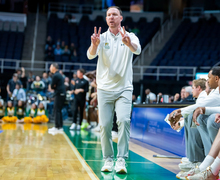Snapchat develops into recruiting resource for coaches 1 year after NCAA recognition
Illustration by Tony Chao | Art Director
Snapchat has become a recruiting tool for coaches over the past year. Jim Boeheim, though, has yet to get with the new age trend.
Picture Jim Boeheim taking a selfie.
Though it sounds ridiculous, it’s not farfetched. Boeheim himself doesn’t have a Snapchat, but many college coaches around the country do. Social media has become an integral part of recruiting in college basketball, and Snapchat is the latest fad.
One year ago Wednesday, the NCAA officially recognized Snapchat as a form of electronic communication to reach out to recruits. The rule went into effect Aug. 1, 2014 and has become widespread in college basketball. Though it has not reached all programs, Snapchat is a means of recruiting that presents both pros and cons according to those who have tracked its emergence.
“At the end of the day, I don’t think kids are making decisions based off who they Snapchat with,” said Evan Daniels, the director of basketball recruiting at Scout.com, “but I think it’s certainly something that can help them get to know the coaches.”
Daniels said Snapchat can be a resource for coaches to show off their program and individual players to recruits. Maybe it’s a postgame celebration or a shot of practice — whatever gets kids excited about playing for a certain school. Recruiting is all about building relationships, Daniels said, and Snapchat has become a way to cultivate those bonds.
Memphis head coach Josh Pastner, for example, uses Snapchat as a recruiting tool, Daniels said. He said Pastner is known for relating to recruits, and Snapchat can be an effective way of doing so.
Some Atlantic Coast Conference coaches enlist their assistant coaches to tackle Snapchat recruiting. Notre Dame’s Mike Brey, for instance, said his assistants are active on the app.
“Thankfully I have a staff that helps me with my technological shortcomings,” Brey said with a chuckle. “They coach me up when I need to be better at stuff.”
Though Brey considers himself inept, he said his daughter is active on Snapchat. Because she’s on Snapchat all the time, he knows other kids are going to be on it too. Nearly everyone he’s recruiting uses the app, so he believes it’s imperative for his staff to do so as well.
Miami’s Jim Larranaga has never come across a recruit who has specifically wanted to Snapchat him. He communicates via phone and text, but many of his assistants use it as a tool.
“High school kids are very tech-savvy, “ Larranaga said, “so we try to do as much as we can with technology.”
Tyler Lydon, a power forward from New Hampshire who is committed to Syracuse, hasn’t connected with coaches on Snapchat personally. He said it would be “kind of weird” to communicate with coaches that way. Snapchat’s more for interacting with friends, he said.
He is intrigued by the idea of a general account with team updates, but he isn’t a proponent of one-on-one Snapchat interaction with coaches.
“If I were uncommitted and a coach were to Snapchat me and say what’s up, I’d probably be cool in the moment,” Lydon said. “But then you think about it and it’s kind of strange.”
Lydon says he doesn’t post anything inappropriate on his Snapchat. He calls himself a laid-back kid and said that’s not his style.
Though Lydon tries to stay away from posting questionable stories on the app, Alex Kline, the owner of The Recruit Scoop, sees a trend emerging where others in Lydon’s position aren’t as wise about what they post on Snapchat.
Kline, who is a junior at Syracuse, said the first thing he thinks of when he hears the word Snapchat is making inappropriate posts without getting in trouble. Recruits can be smart on Twitter, Facebook and Instagram, Kline says, but they may act in negligent ways on Snapchat. Though Snapchat has perks in recruiting, Kline sees the trend in a more negative light.
He considers Snapchat a background check to spy on people. Though kids don’t have to accept coaches’ requests, they often do. Snapchat is considered private, but it’s really public, Kline says. He believes many people create a brand on other social media but show their true selves on Snapchat.
Though individual Snapchats can only last up to 10 seconds, Snapchat Stories stay up for a full day. Many of these big-time recruits have hundreds of Snapchat friends, including some coaches. If a player is drinking, smoking or acting inappropriately, for example, that coach may be less inclined to reach out.
Kline hasn’t seen any specific examples, though he sees the trend continuing in the coming years.
“People are trendsetters and people are followers, especially in basketball,” Kline said. “Once you’re wearing these Kobes and these Jordans, the next person’s going to do it. I think the same goes for social media.”
Although Snapchat has yet to dominate college basketball recruiting, it appears to be gaining traction around the country. Coaches can interact with recruits, and vice versa, and both parties get a chance to learn about the other.
But that might not always be a good thing.
“Some of these guys are reckless,” Kline said. “Snapchat is the new thing that’s going to expose that.”
Published on February 10, 2015 at 12:22 am
Contact Trevor: tbhass@syr.edu | @TrevorHass





